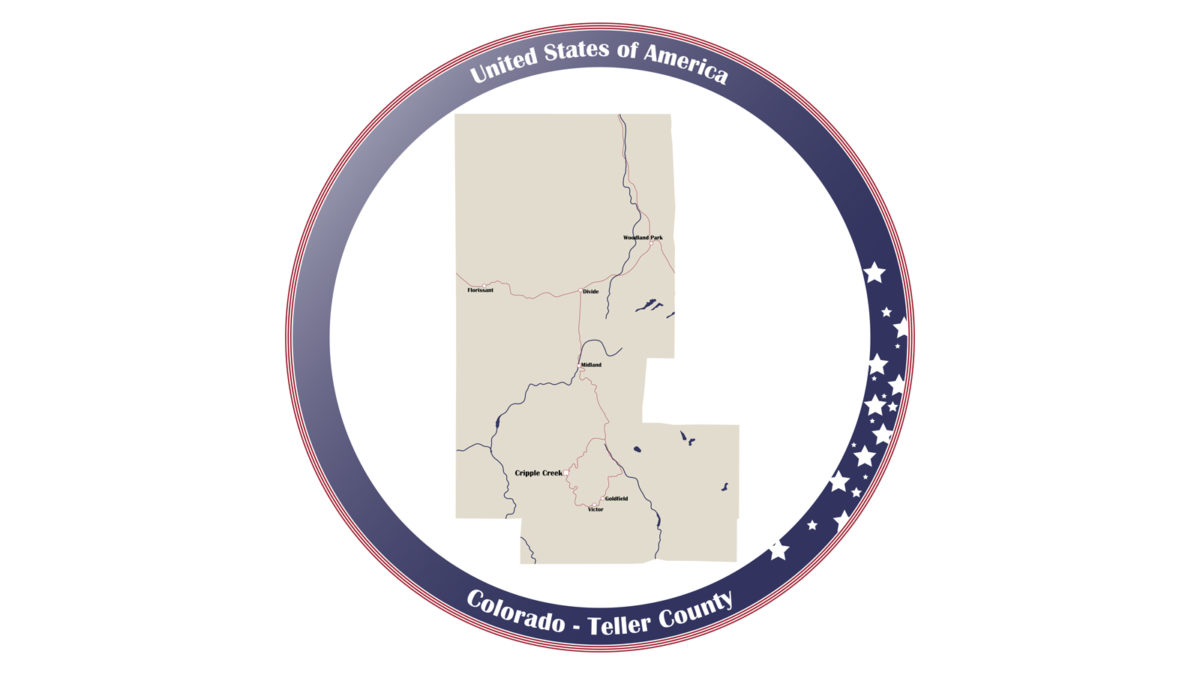
Gunfight at the Polls
The James Warford Murder Trials
December 2020
Download This Article (.pdf)
On November 8, 1904, residents of Teller County, Colorado went to the polls. They cast their votes against a backdrop of violence and fear. For the past two years, the Cripple Creek mining district and other mining regions in Colorado had been torn apart by a series of bloody labor disturbances. Striking miners and mill workers, strikebreakers, vigilante groups, and the Colorado National Guard had engaged in shootings, beatings, threats, arbitrary arrests, and sabotage. Things got so bad that Colorado’s governor had imposed martial law. The labor war culminated in an explosion at the Independence Depot on June 6, 1904 that killed 13 strikebreakers.
Five months later, on election day, things were still tense. “Every man in almost the entire camp [was] a walking arsenal” and “excitement and tension [were] at the highest pitch.”1 It was clear to Teller County’s officials and citizens that extraordinary measures would be needed to keep the peace. “[T]o this end the sheriff of the county, the board of county commissioners, and the central committees of the different parties entered into an agreement that on election day there should be at each polling place one deputy sheriff and one constable only to preserve order and see to the enforcement of the law.”2
This admirably nonpartisan plan attempted to ensure electoral calm. But its effective enforcement could only be assured if the sheriffs and constables could cooperate with each other. And that depended to some degree on the character of the men involved.
At Teller County Precinct No. 48, located in the boomtown of Goldfield, James Warford was one of the deputies chosen to watch the polls. One could hardly have picked a worse man for the job. Warford and his fellow poll-watcher, Thomas C. Brown, were duly and legally appointed acting Teller County deputy sheriffs. But Warford was not the sort of impartial peacekeeper the task required.
Warford had previously been employed by one of the major combatants in the labor war, the Mine Owners’ Association. He had pursued his employer’s interests with vigor, and his enemies had learned to fear him.3 His exploits included helping to wreck a local newspaper office, during which it was reported that he literally killed time by firing a bullet through a clock face.4 His conduct on election day 1904 would prove to be no less extreme.
The constables chosen to man Precinct No. 48 were not much better. Despite the agreement that only one constable and one deputy sheriff would be assigned to each polling place, election judges directed three constables to show up at the precinct. Two of the three were Isaac T. Leabo and Chris Miller.5 Both Leabo and Miller were members of the Western Federation of Miners, sworn opponents of the Mine Owners’ Association. Things went about as well as one might expect.
The Shooting
Brown later testified that on the day of the election, Warford approached Miller and Leabo, who were sitting on a fence in front of the polling place, and said, “You gentlemen will have to move outside of the 100-foot limit.”6 Brown claimed Miller and Leabo responded by drawing their guns. But Warford was the faster gunman. He shot and killed them both.
Warford’s First Murder Trial
Warford was charged with Leabo’s murder. His first trial took place in March 1905. After deliberating for 67 hours, the jury ended up hopelessly deadlocked, reportedly 6 to 6.7 Warford remained in jail for a couple more months while the prosecutor decided whether to retry him. On May 13, 1905, the prosecutor dismissed the case, and Warford was released from jail.
Warford Holds Up the Sheriff
Warford wasted no time getting into more serious trouble. Less than a week later, in an exploit that made headlines across Colorado, he held up the Teller County sheriff, Edward Bell.
The bizarre events began when Warford and an associate, Walter Kenly, who had also recently been discharged from the Teller County jail, went to the Cripple Creek sheriff’s office to get their revolvers back.8 When they showed up Sheriff Bell told Warford, “All right, Jim; I will go up and get them for you.”9 For whatever reason, Warford stepped out of the office, leaving Kenly alone with the sheriff. Unfortunately for Kenly, the sheriff noticed that he had a revolver on his person. The sheriff seized the gun and placed Kenly under arrest for carrying a concealed weapon.
Warford returned to find that his friend had been arrested and was on his way back to jail. Warford’s guns were also kept at the jail, so he and Sheriff Bell headed in that direction to retrieve them. On their way, Warford mentioned to the sheriff that Kenly was carrying a second revolver on his person.
When they encountered Kenly and the deputy who was escorting him to jail, Sheriff Bell told Kenly to “[g]ive me that other gun you’ve got.”10 In response, Kenly drew his revolver and pressed it against the sheriff’s stomach. Warford also drew his gun and told the sheriff, “Don’t make a damn fool of yourself, or you will get killed.”11
Sheriff Bell and the deputy realized the two men had the drop on them. They told them that if they wanted their guns back, they would have to come to the jail and get them. Once they reached the jail, Warford and Kenly told the sheriff and the deputy to go inside and to set their firearms outside the door. But while the officers were inside the jail, Warford and Kenly apparently changed their minds about retrieving the guns. Instead, they disappeared.
The sheriff immediately called up a posse to track them down. The posse caught up with the men about a mile south of Cripple Creek on a railroad track. Shots were exchanged. Warford, shot in the leg, stumbled down a hill, cracking his skull. Recognizing they were surrounded, the men surrendered. The deputies hauled them off to jail, and they were charged with assault with intent to murder.
Warford’s Second Trial and Sentencing
The prosecutor decided at this point to reinstate the Leabo murder charge against Warford. He was tried a second time for that murder. He was also tried on the assault with intent to murder charge. Warford was convicted of both offenses in separate trials, and on December 28, 1905, the district judge sentenced him to life for the murder and 12 to 13 years for the assault charge.
The Murder Appeal
Warford soon had two separate appeals pending before the Colorado Supreme Court. In the first, he challenged his conviction for murdering Leabo at the polling station based on the district court’s refusal to admit two key pieces of evidence at his trial.
First, Warford had sought to explain why he told the two constables to move away from the polling station. He made the following offer of proof. A deputy named Jack Allen, who supervised the Goldfield sheriff’s deputies, had assigned Warford and Brown to serve at Precinct 48. It was Allen who told Warford and Brown to remove Miller and Leabo outside the 100-foot limit. Allen took this measure so that only a single constable and a single deputy sheriff would remain at the poll, in compliance with the county officials’ agreement. The jury never heard this explanation for Warford’s actions, which could have cast them in a considerably different light.
In response, the state made an interesting but ultimately irrelevant argument. It contended the evidence of Warford’s attempts to comply with Allen’s order had in fact been inadmissible:
[T]he agreement . . . was an absolute nullity because it was an attempt to deprive the judges of election of the power to appoint constables, conferred on them by the statute, and that Mr. Allen exceeded his authority as deputy sheriff in attempting to carry out the agreement in ordering [Warford] to remove Leabo and Miller from the 100-foot limit, and therefore such orders afforded no justification for any attempted interference with Leabo and Miller by [Warford].12
But the Colorado Supreme Court reasoned that even if the county officials and committees had acted without authority, that was not the real issue. The real issue was whether Warford believed he had authority to order Leabo and Miller to move. This issue was relevant to whether he had acted with malice, an essential element of the crime of murder. The trial court had therefore committed prejudicial error by excluding testimony that bore on this essential issue.
The second piece of evidence the trial court had excluded went to Warford’s theory of self-defense. He sought to present evidence that 15 minutes before the shooting, a witness had told Warford that Miller and Leabo had made threats against him. The witness would also have testified he told Warford that Miller and Leabo “were known to be dangerous men, and were likely to cause trouble, and to be careful and take no chances with them.”13
The state argued that this testimony was properly excluded because Warford “was the aggressor, in that he acted without authority and approached [Leabo] in a hostile manner.”14 But given Warford’s explanation of the events, the Court reasoned, this evidence should have been admitted to explain his actions.
Given the improper exclusion of these two pieces of evidence favorable to the defense, the Colorado Supreme Court reversed Warford’s murder conviction.
The Assault Appeal
Warford was less successful in his appeal of the assault conviction. Six months after it reversed the murder conviction, the Colorado Supreme Court affirmed his conviction (and Kenly’s) for assault with intent to murder. The most interesting issue in that appeal involved an alleged variance or ambiguity between the assault alleged in the information and the one proved at trial.
The information charged a single assault count. It did not specify whether the assault took place at the jail (when Warford and Kenly pulled their guns on the sheriff) or on the railroad tracks (when they exchanged gunfire with members of the posse). Prior to trial, the defendants filed a motion to require the district attorney to elect which assault it had charged. The district court denied the motion. The Colorado Supreme Court affirmed, stating that the pretrial motion had been premature because such a motion would not ripen “until the testimony disclosed that the prosecution was attempting to establish a state of facts tending to establish a state of facts tending to prove the commission of two or more substantive offenses.”15
After the prosecution put on evidence at trial concerning both the assault at the jail and the assault on the railroad tracks, the district court agreed with the defendants that the prosecution was required to elect one or the other to be the offense charged. The district attorney chose the assault on the railroad tracks. The jury convicted Warford and Kenly of that assault.
They next argued that if they were charged with the assault on the tracks, it was unfair and confusing to the jury for the prosecution to put on evidence of the assault at the jail. The Court disagreed. Although evidence of the first assault was not part of the res gestae of the second, it was relevant to show the defendants’ motive and intent in firing on the posse on the railroad tracks. It helped that the trial court had instructed the jury that evidence of the assault at the jail could only be considered in determining the defendants’ motive and intent in perpetrating the assault at the railroad. (Similar limiting instructions are of course used today when evidence of prior crimes or wrongs is introduced.) Although it would have been preferable to give the limiting instruction at the time the evidence was presented, the defendants were not prejudiced by its submission with the other jury instructions at the close of trial.
The defendants also argued that because they shot at the sheriff and his posse from a distance of 150 yards and did not hit anyone, it could not be inferred that they had the intent to kill any particular person. The Colorado Supreme Court easily rejected this contention, stating “[i]f this be the law, then one may discharge a firearm towards and into a crowd with impunity, provided his aim is not sufficiently accurate, or he is so fortunate as not to wound any one.”16 In any event, there was testimony that the defendants had been aiming at the sheriff.
The defendants tried a similar contention, arguing that their revolvers had an accurate range of only 75 or 80 yards and they had shot from nearly twice that distance, so they could not have intended to kill the sheriff. The Court rejected this contention as well, reasoning that even if the revolvers were not accurate at that range, bullets fired from them could still travel the 150 yards to the sheriff, and that was close enough.
The defendants raised a few other issues, but the Court found them meritless. It affirmed their convictions.
Third Murder Trial and Pardons
Warford and Kenly did not spend long in prison. In December 1908, the governor pardoned them for the assault on the Teller County sheriff. Not surprisingly, they were recommended for this pardon by Sherman Bell, the controversial, eccentric, and autocratic commander of the Colorado National Guard during the 1903–04 labor wars.
Warford still had the murder charges from the Leabo/Miller incident hanging over his head. He was rearrested for this murder in February 1909 and tried a third time for it. Once again, the jury deadlocked. The prosecutor announced that a fourth trial was unlikely; the state did not want to spend the money.
Warford’s Final Battle
James Warford did not escape retribution for long, however. In April 1912 his frozen body was discovered on Battle Mountain. A newspaper account described the corpse as follows: “The face and chest of the man were literally riddled with bullets, and three bullet holes in the back clearly indicates [sic] that after he had fallen the murderer had shot him in the back. The cold hand of the dead man clasped a gun, but not a shot had been fired. The body when found was frozen stiff . . . .”17
A union journal would later report that Warford had been betrayed and killed by his criminal associates.18 But apparently no one was ever tried for the murder. One thing seems certain: James Warford lived by the gun and he died by the gun. 
Notes
1. “Election Riot in Cripple Creek,” Salida Mail at 3 (Nov. 11, 1904).
2. Warford v. People (Warford I), 92 P. 24, 24 (Colo. 1907).
3. “Bad ‘Gun Man’ To Soon Get New Trial,” Aspen Daily Times at 1 (Oct. 8, 1907).
4. “Killed by Pals,” United Labor Bulletin at p. 2, col. 3. (Apr. 25, 1912).
5. The name of the third man was not identified in the Colorado Supreme Court’s decision.
6. Warford I, 92 P. at 24.
7. See Yuma Pioneer at 5 (Mar. 17, 1905).
8. Contemporaneous newspaper accounts also mention a third man with them, John Chapman, who does not figure in the Colorado Supreme Court’s decision.
9. Warford v. People (Warford II), 96 P. 556, 557 (Colo. 1908).
10. Id. at 558 (internal quotation marks omitted).
11. Id. (internal quotation marks omitted).
12. Warford I, 92 P. at 25–26.
13. Id. at 24 (internal quotation marks omitted).
14. Id. at 26.
15. Warford II, 96 P. at 557.
16. Id. at 559.
17. “Gun Fighter Found Riddled with Bullets,” Cañon City Record at 1 (Apr. 18, 1912).
18. See “Killed by Pals,” supra note 4 at 2.
But the Colorado Supreme Court reasoned that even if the county officials and committees had acted without authority, that was not the real issue. The real issue was whether Warford believed he had authority to order Leabo and Miller to move.


